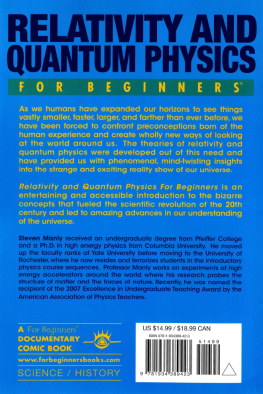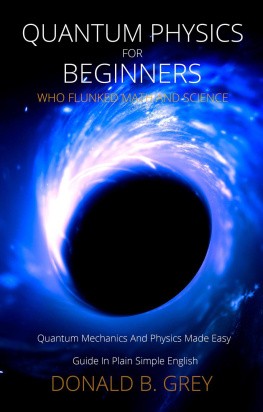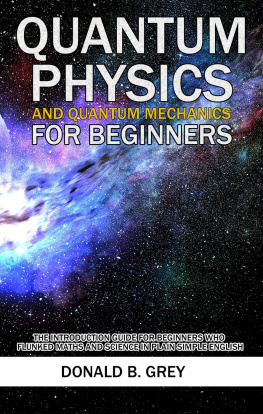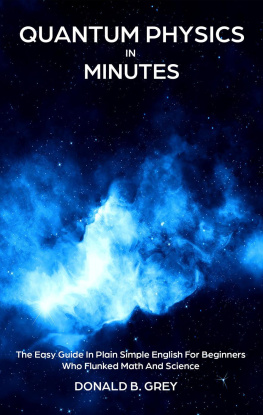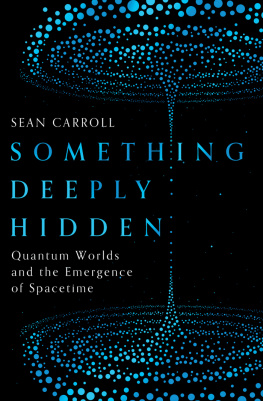Darrell Ason - QUANTUM PHYSICS FOR BEGINNERS: An Easy Guide for Discovering the Hidden Side of Reality One Speck at a Time
Here you can read online Darrell Ason - QUANTUM PHYSICS FOR BEGINNERS: An Easy Guide for Discovering the Hidden Side of Reality One Speck at a Time full text of the book (entire story) in english for free. Download pdf and epub, get meaning, cover and reviews about this ebook. year: 2021, genre: Romance novel. Description of the work, (preface) as well as reviews are available. Best literature library LitArk.com created for fans of good reading and offers a wide selection of genres:
Romance novel
Science fiction
Adventure
Detective
Science
History
Home and family
Prose
Art
Politics
Computer
Non-fiction
Religion
Business
Children
Humor
Choose a favorite category and find really read worthwhile books. Enjoy immersion in the world of imagination, feel the emotions of the characters or learn something new for yourself, make an fascinating discovery.
- Book:QUANTUM PHYSICS FOR BEGINNERS: An Easy Guide for Discovering the Hidden Side of Reality One Speck at a Time
- Author:
- Genre:
- Year:2021
- Rating:4 / 5
- Favourites:Add to favourites
- Your mark:
- 80
- 1
- 2
- 3
- 4
- 5
QUANTUM PHYSICS FOR BEGINNERS: An Easy Guide for Discovering the Hidden Side of Reality One Speck at a Time: summary, description and annotation
We offer to read an annotation, description, summary or preface (depends on what the author of the book "QUANTUM PHYSICS FOR BEGINNERS: An Easy Guide for Discovering the Hidden Side of Reality One Speck at a Time" wrote himself). If you haven't found the necessary information about the book — write in the comments, we will try to find it.
Darrell Ason: author's other books
Who wrote QUANTUM PHYSICS FOR BEGINNERS: An Easy Guide for Discovering the Hidden Side of Reality One Speck at a Time? Find out the surname, the name of the author of the book and a list of all author's works by series.
QUANTUM PHYSICS FOR BEGINNERS: An Easy Guide for Discovering the Hidden Side of Reality One Speck at a Time — read online for free the complete book (whole text) full work
Below is the text of the book, divided by pages. System saving the place of the last page read, allows you to conveniently read the book "QUANTUM PHYSICS FOR BEGINNERS: An Easy Guide for Discovering the Hidden Side of Reality One Speck at a Time" online for free, without having to search again every time where you left off. Put a bookmark, and you can go to the page where you finished reading at any time.
Font size:
Interval:
Bookmark:
Quantum Physics for Beginners
An Easy Guide for Discovering the Hidden Side of Reality. Discover How the Quantum Physics Phenomena Influence Your Cosmos.
Darrell Ason
Table of Contents
Introduction
Welcome to Quantum Physics for Beginners ! Does the thought of learning quantum physics make you want to curl up in a ball and cry? Then you have come to the right place because we're here to wipe away those tears and turn that frown upside down. We're going to take a real-world, relatable look at the science behind the tiniest pieces of our universe and the scientist who study them. Part of the reason quantum physics is so intimidating is that the subject is often fraught with indecipherable formulas and fancy terminology that leaves the average human scratching their head and throwing up their hands.
So go ahead and use those stuffy textbooks to prop up the uneven legs on the table you inherited from Aunt Sarah and Uncle Joe. Sure, we're going to have to tell you about some of the math, but we promise it won't be painful. Even better, there won't be a test at the end. Just sit back, relax, and come on a fun, sometimes-irreverent ride that will take you from the discovery of the atom through the astonishing science of the greater universe. We're going to take a look at some of the most brilliant minds that ever grace a laboratory, the experiments they developed and presented to the world, and why sometimes, even these geniuses were misguided in their pursuits.
Quantum physics strives to recognize and explain how the universe's tiniest pieces all fit into the big picture. If there comes a time when human beings can journey to and live on other worlds, it's going to be because of quantum physics. If we ever want to travel through time, it's going to be because of quantum physics. And if you have no interest in those things, but you'd really like a teleporter to get your errands done a little quicker- you guessed it- it'll take some pretty solid quantum physics. Yes, these things all sound more like science fiction than science fact, but have you ever read any good ol' pulp sci-fi? Some of that stuff has already come true, so there's always hope!
The point we're trying to make is that quantum physics isn't something you need to be afraid of. As you work your way through the book, you'll realize that the scientists who founded and continue to study quantum physics might be wired a little differently (looking at you, Schrdinger!) Still, they're human beings who want the same thing as you, to know and understand the nature of the world and the vast universe around us. We can't do that without first looking at the smallest components that make up, well, everything! It's time to take a journey back a couple of centuries and take a peek into the first theories of the atom. Then we'll take a linear jaunt through the history of quantum physics. Let's get started, shall we? No time like the (relative) present, as Einstein would say. Maybe. He was a weird dude, too.
Chapter 1: The Infancy of Quantum Physics
Scientists didn't just wake up one day with a laboratory full of fancy electron-scanning microscopes and mass spectrometers. It took years of discovery and experimentation to get to the understanding of quantum physics that we have today. The story of quantum physics, which holds a dictionary definition of "the branch of physics concerned with the quantum theory" (helpful, huh?), begins with the story of classical physics. This, of course, is the scientific discipline that aims to use mathematics and mechanics to explain how the world works. So, where does the fundamental split between classical and quantum physics occur?
The truth is, there is no specific date or definitive line that shows us where classical physics ends and quantum theory begins. Like a snowball rolling downhill, the theories that would evolve into quantum studies started slowly, building up momentum and growing- and that snowball eventually became an avalanche that is still roaring today. It was innate human curiosity that instigated the first experiments that would lead to the creation of quantum physics as a separate field of study. When scientists found that they couldn't explain things using the laws of classical physics, they went looking for their answers elsewhere. Thus, quantum physics, quantum mechanics, quantum chemistry, and every other quantum discipline was born.
Even before the apple could fall on Newton's head and spark the origin of classical physics, quantum physics made a brief debut. The earliest concept of the atom was actually introduced circa 400 BCE by the Greek philosopher Democritus. He proposed a so-called Theory of the Universe that subscribed to the following principles:
- all matter consists of atoms; these are too small to be seen
- there is empty space between all atoms
- atoms are solid but have no set internal structure
- every substance is made of different atoms, with their own weight, size, and shape
This early theory is surprisingly accurate, albeit generalized. Given that Democritus based his theories on philosophical thought experiments rather than scientific study, this theory's accuracy is even more surprising. He firmly believed that all substances could be divided and divided again and again until only the smallest elements of that matter remained- and that smallest particle is that which he dubbed "the atom." His theory would remain widely accepted but largely untouched until the turn of the 19 th century.
Early Atomic Models
Sometime shortly after 1800, British scientist John Dalton turned his attention away from his eclectic studies in meteorology and physiology and tried to figure out Democritus's atomic theory, making him the first modern researcher to put any serious thought into the centuries-old hypothesis. Dalton released his atomic theory in 1808, which rehashed many of Democritus's ideas but also threw in a new twist, the introduction of atomic weights to determine one substance from another. Dalton's Atomic Theory looked like this:
- all matter is made up of tiny particles known as atoms
- atoms cannot be destroyed or changed
- atoms and elements are distinguishable by their weights
- elements react to each other and form new compounds out of their combined atoms
While Dalton's model was closer to the truth and more accurate than Democritus's, it wasn't without controversy. Unfortunately, the controversy stemmed not from the content of the hypothesis, but from an accusation by Irish chemist William Higgins that Dalton had stolen his work. It turns out Dalton hadn't. He'd actually taken much of his research from Higgins's uncle, Bryan Higgins, a naturalist and chemist himself. That's some defense, isn't it? Imagine Dalton pounding his fist on a table, hollering, "How dare you accuse me of stealing your ideas?!? I would never! I stole your uncle's, as they are much better!"
In all factuality, Dalton did base his concepts on both the original atomic theory proposed by Democritus and the elder Higgins, but the theory he released was proven to be very much his own. Notebooks from Dalton's laboratory prove that he was engaged in unique, proprietary experiments that even went so far as to suggest the relative weights of several elements. Despite not having many original ideas, he did study the concepts in a new way, and for that, he is the great-grandfather of the atomic model. Dalton's papers were preserved and archived in Manchester, England, but many were lost in the 1940 Christmas Eve blitzkrieg.
The next atomic theory was proposed by British physicist JJ Thomson, and it bears the fun moniker "the plum pudding model." Thomson is widely credited with discovering the electron using cathode rays (more on those shortly!) and consequently released his revamped atomic model in 1904. Plum pudding, for those not well-versed in British desserts, is a sweetened bread pudding chock full of butter and brown sugar and flocked with raisins or currents. It was, and still is, a favorite in the United Kingdom. With his discovery of the electron, Thomson actually took the atomic model farther away from accuracy. He had discovered what they were (negatively charged parts of the atom) but not how they worked.
Next pageFont size:
Interval:
Bookmark:
Similar books «QUANTUM PHYSICS FOR BEGINNERS: An Easy Guide for Discovering the Hidden Side of Reality One Speck at a Time»
Look at similar books to QUANTUM PHYSICS FOR BEGINNERS: An Easy Guide for Discovering the Hidden Side of Reality One Speck at a Time. We have selected literature similar in name and meaning in the hope of providing readers with more options to find new, interesting, not yet read works.
Discussion, reviews of the book QUANTUM PHYSICS FOR BEGINNERS: An Easy Guide for Discovering the Hidden Side of Reality One Speck at a Time and just readers' own opinions. Leave your comments, write what you think about the work, its meaning or the main characters. Specify what exactly you liked and what you didn't like, and why you think so.


